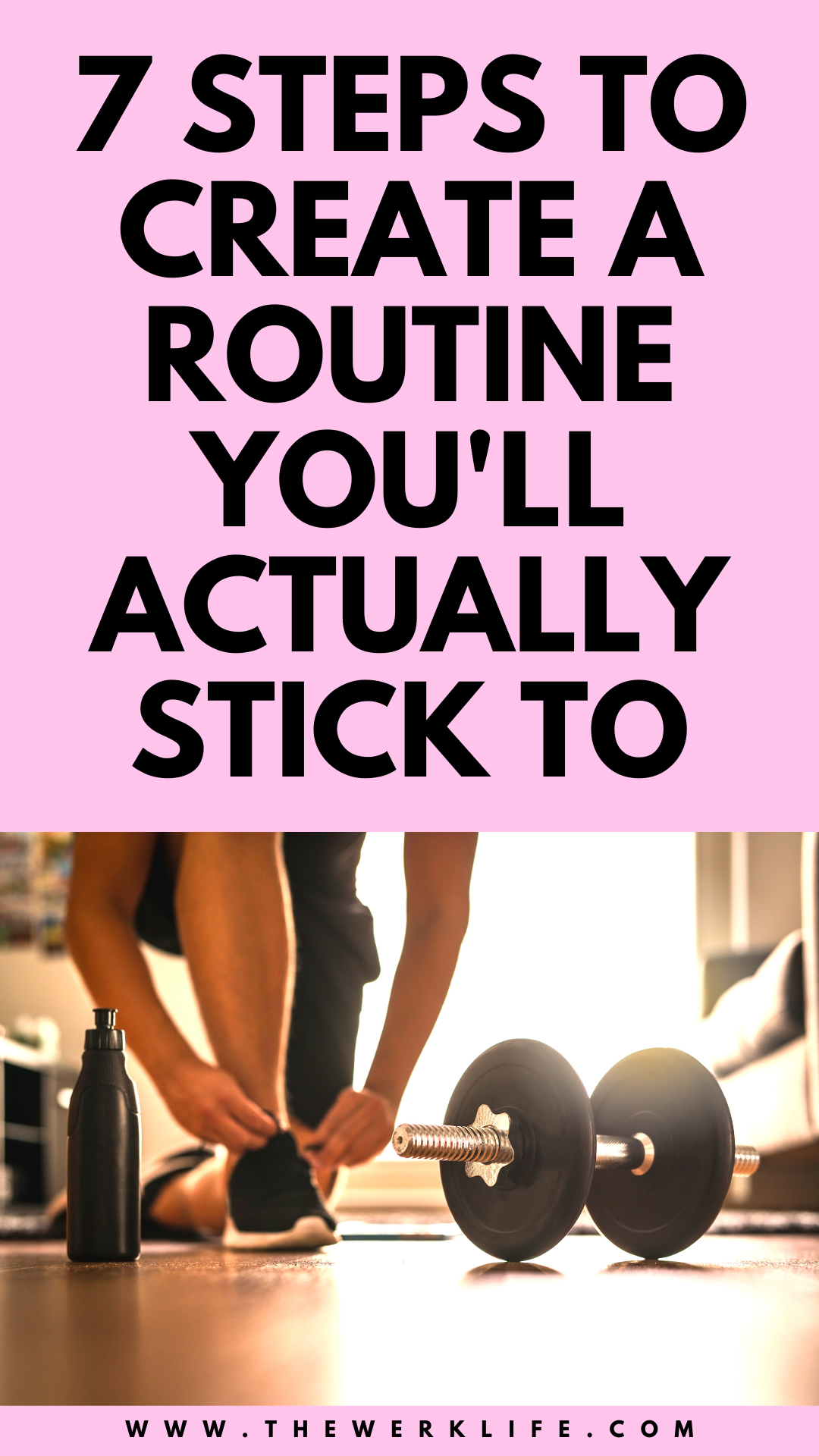Create a routine and your life will change, they say. But creating a routine and sticking with it – that’s the hard part.
How to Create a Routine You’ll Stick To
Benefits of a daily routine
There’s no doubt that having a daily routine comes with a lot of benefits. From helping you manage stress and anxiety, to having a foundation for structure and consistency – creating a routine can help you focus on those small habits that lead to big results.
But the hard part, is building a routine that you’ll actually stick to. One that’s attainable, sustainable, and that you actually look forward to doing every single day.
Today, we’re covering 7 steps to help you create a routine you’ll want to stick with, and get that motivation going. Whether it’s a morning routine, a night routine, or a workout routine, these tips apply to building any sort of routine in general. So let’s kick things off with step #1…
1. What are your aspirations?
The desire to build a routine, usually comes from some sort of impulse or yearning to be this better version of yourself. You might crave structure or consistency, because you feel overwhelmed and scatter brained. Or maybe you feel like you need a solid system in place to repeat habits on a regular basis, so you can get to where you want to be.
And all of these things come down to our aspirations.
Finding these aspirations could involve doing the “Who am I Today?” and “Who do I Want to be in the Future?” assessment, or it could be as simple as setting a few goals for yourself.
Get very clear on what you aspire to do or become and that is going to be your north star for creating a routine.
2. What type of routine do you want to build?
Based on your aspirations, the next step is to get clear on what type of routine you want to build.
Generally, a daily routine consists of many small routines and rituals that we might not even think about. If you work 9-5, Monday to Friday, that in itself is a routine. If you’re in school and you have your class schedule, that overtime becomes a weekly routine.
So you need to understand if you’re trying to build on top of these existing rituals of life that are in place, or if you’re trying to incorporate more structure within them.
For example, let’s say currently, you work a 9 to 5. Part of your aspirations are to be more calm, cool, and collected throughout the day, but also feel stronger and healthier. So, you may decide a morning routine where you meditate and workout before work, is what you need. In that case, you’re building a new routine outside of your current schedule. You’re building a routine on spare time that you have before work.
On the contrary, let’s say you work a 9 to 5, and part of your aspirations are to be more organized at work and on top of your game. You may decide that the routine you need, is that once you get to work everyday, from 9am to 10am, you’re going to check emails, set priorities, and have meeting free focused time.
Get clear on what type of routine you want to build and for what purpose.
3. Plan out an attainable schedule
Before getting into the process of building any sort of routine, you need to be totally honest with yourself.
As in, how much time am I actually willing to put into a routine? And how much time can I actually put into a routine?
Sure, the 5am morning routines might sound great, but if you’re someone that works until 9pm every night, and you only get home at 10 or 11, is 5am truly attainable? Or, is that just going to burn you out?
Get real with yourself about what your current commitments are. Work, school, volunteering, family time — start by listing out those things in your daily schedule that are a total must.
Once you’ve done that, you should be able to see a pattern. As in, maybe every evening you have 3 hours of spare time. Maybe every morning you have 2 hours of spare time.
Using the example from the last point, if you work a 9 to 5 and you want to start having a morning routine, but are the farthest thing from being a morning person. 5am might not be where you start. Maybe you start with a 30 min morning routine where you can wake up later, and meditate for 10 minutes, and go on a 20 minute walk.
Overtime you can build that up, but you want to start with something that’s attainable.
And looking at the other example of a routine during work, you may not be able to take the first hour of work to have focused time. Maybe you have a team huddle everyday from 9:30am to 10am. If that’s the case, maybe you create a routine from 9:00am to 9:30am or start it after the daily huddle.
Get clear about what’s currently taking up your time.
Manage your schedule
You’re going to want to use techniques like time-blocking, where you actually chunk off time in your calendar to dedicate to your routine or the habits that make up your routine. Get specific here, actually mark things down, and treat it like you would any other commitment.
4. Give yourself buffer room
The key to a successful routine, is not to overdo it. When things are too rigid, and we don’t allow room for flexibility, systems tend to collapse and we are back at square one.
Make sure you build in buffer room or extra time in your routine so you don’t feel like everything is so robotic. A routine does start to feel habitual overtime, but there might be days where things don’t go so according to plan. Maybe you sleep in an extra 15 minutes, maybe you hit traffic on the way to the gym.
Things happen, and know this as you build your routine.
You should be able to quickly adjust something in the event something takes longer than usual. For example, some mornings you may only have 5 minutes to meditate instead of 10. Not ideal, but at least you still did it. It’s the consistency that matters.
Don’t try to fit a million things into an hour or you will start to dread your routine. Keep it simple, be flexible, and give yourself buffer room.
5. Build in down time
Though we can get a lot done when every minute of our day is planned, it’s simply not human.
We’re not robots at the end of the day, and we do need some spontaneity and free time to do whatever we want to do.
So as you’re building a routine, remember to keep things light. Your whole day doesn’t need to be regimented from sunrise to sunset.
Build in downtime, give yourself some time every day where your routine is having no routine, and you do whatever you want in that moment. Maybe that’s a few hours a day for some, maybe that’s a half hour every night for others — do what works for you.
This is the time you want to reward yourself and just flow, instead of worrying about what needs to be done next.
This is so important for your mental health and just physical being, so don’t stress too much about having every single moment planned with routine.
6. Tweak it overtime
As with anything in life, we are not going to nail the perfect formula right out of the gate.
Creating a routine you’ll stick to involves trial and error, iterating, and seeing what works and doesn’t work for you.
You may have seasons in your life where you love waking up at 5am, and other times where you wake up at 7am. There’s no wrong or right, you need to feel what works for you and makes you feel like the best, happiest, healthiest, and most creative version of yourself.
A good rule of thumb is to try something out for 21 days and see how you feel coming out of it. Our bodies takes time to adjust to anything new, so even after those 21 days if you feel like something’s up, tweak your routine, try something a little different, and keep pulling on those levers until you find what the best outcome is for you.
7. Make sure it’s true to you
Last but not least, keep in mind that it’s your routine. It’s not someone else’s. There is not one single way to get to a destination, there is not one single way to solve a problem, there are many paths we can take to get to where we want to be, and it’s not a one size fits all.
The latest trend might be a morning routine that everyone is doing, but it doesn’t mean you have to do it. Nor does it mean it will work for you.
It’s great to get inspiration and ideas from other people’s routines. Take what you need from that inspo, but don’t feel like you need to copy and paste it exactly.
Do the things that matter to you at the times that work for you, and focus on your aspirations, not everyone else’s.
Read more:
- How to Change Your Life in 90 Days
- How to Create a Morning Routine You’ll Actually Stick To
- 10 Daily Habits to Improve Your Life Right Now
Stay connected!


